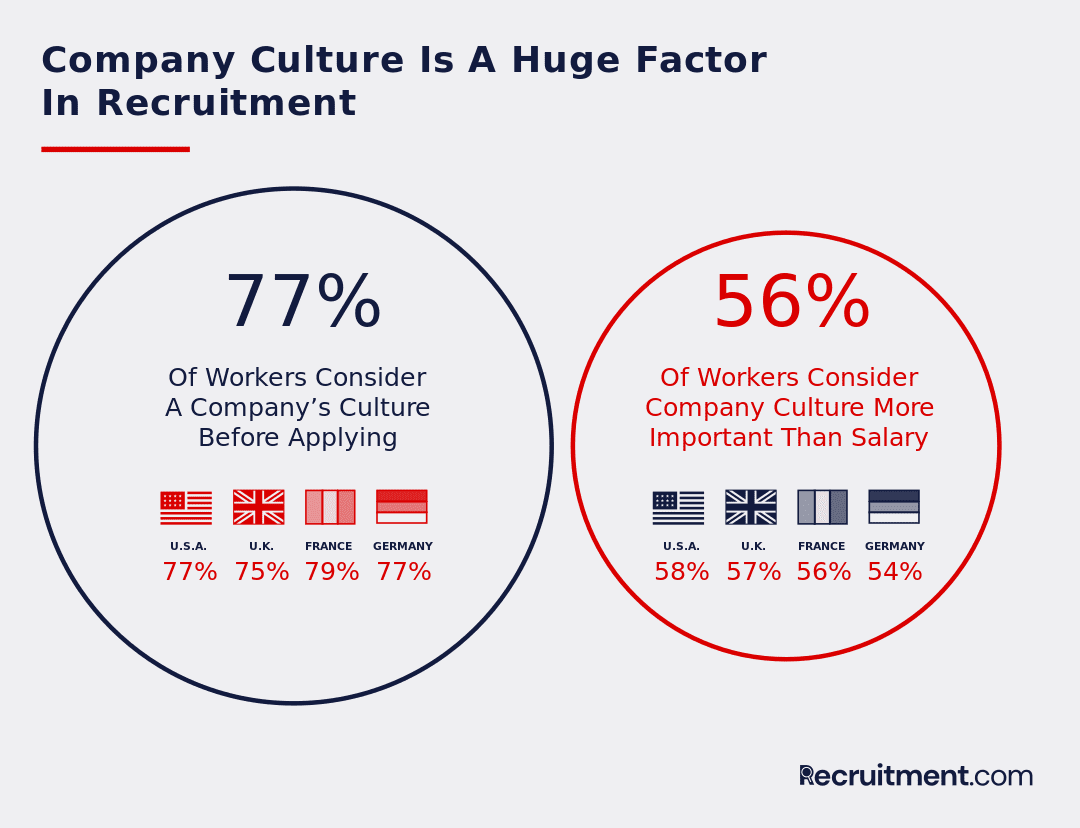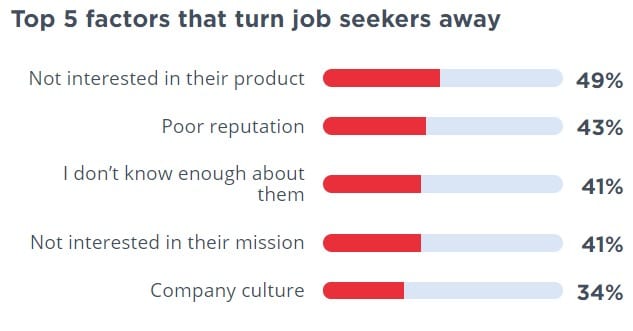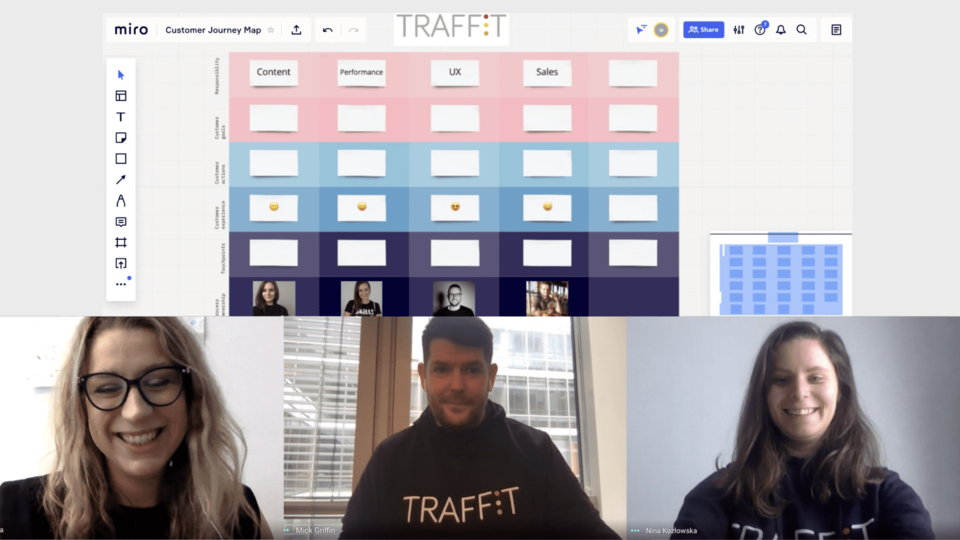The following article is written by Dean Mathews, the founder and CEO of OnTheClock, an employee time tracking app.
Thanks for contributing to our blog!
Successful companies are built on a foundation of great talent—but a strong external employer brand means nothing for attracting top talent if it doesn’t align with your company’s internal culture. Here’s how to build a strong work culture that reinforces your employer brand and attracts top talent.
Why Company Culture Matters
Employee expectations have shifted in recent years to include factors beyond the paycheck. A LinkedIn survey found that people would rather forgo titles (26%) and accept lower pay (65%) than suffer in a bad work environment.
Company culture has become one of the leading factors in retaining top talent, attracting hot prospects, and driving productivity. Company culture refers to the common set of behaviors, mindsets, and beliefs that shape how employees work and interact in the workplace. Candidates seek workplaces where their beliefs align with those of the company and where they can work together with like-minded people towards a common goal.
Company culture impacts your business in the following ways:
- Strong culture drives ROI: Companies in the top quartile of cultures posted200% higher returns to shareholdersthan companies in the bottom quartile.
- Flexible cultures are more Agile: A healthy culture drives competitive advantage by inspiring employees to work together to adapt to changes and find creative ways to succeed.
- Collaboration drives innovation: A company culture of inclusivity promotes collaboration, which eliminates silos between teams and drives innovation.
- Culture attracts better candidates and retains top talent: 77% of candidates factor incompany culture before applying for a job and 71% of employees would walk away from a job without a supportive organizational culture.

How Company Culture Reinforces Your Employer Brand
Your corporate brand refers to how your company is perceived in the market by customers.
Employer brand refers to the factors that shape how prospective job seekers view your work culture and values as a company. In competitive job markets like the tech industry, understanding the distinction between the company brand and employer brand can help companies source stronger candidates.
External perception isn’t enough; you need to ensure your brand image aligns with your company’s internal culture to give candidates a realistic perception of how your company functions internally. An authentic culture that trickles down from the top and is supported by core values helps HR source prospects that align with and are excited by the values and mission of the company.
The drive for authentic company culture is continuing to grow. In 2019, candidates identified poor reputation, lack of interest in the company mission, and misalignment with company culture as leading causes for not taking a job.

Establishing a strong employer brand assists in hiring efforts in the following ways:
- Attracts more informed candidates to your job postings
- Helps move candidates down the funnel more efficiently
- Establishes credibility and drives competitive advantage during the hiring
- Improves the retention of your existing workforce
Employees also connect better with company culture when it empowers them to feel engaged, valued, and heard. It is leadership’s responsibility to build and improve culture through improving role fit, establishing strong connections in the workplace, and connecting roles to the purpose.
How to Build a Successful Work Culture That Attracts Top Employees
It’s critical to dedicate time to define your culture or risk developing a toxic workplace environment that attracts the wrong type of talent. Start by documenting the core values that define your organization. From there, business leaders should focus on the following factors that can build a strong employer brand.
1. Connect Roles to Purpose and Career Paths
When employees believe their work matters, they’re more likely to be engaged, motivated, productive, and fulfilled. However, a gap exists between the idea of purpose and the practice of implementing it to develop a positive company culture.
79% of business leaders think that connecting people to purpose is critical for business success, but only 34% use it as a pillar for decision-making. To be fully engaged and build a culture that reinforces a strong employer image, employees need to find meaning in their daily work—but fewer than half say they do.
Connecting roles to purpose can impact employees in the following ways:
- Helps employees understand why their work matters and how it impacts the organization.
- Purpose-driven roles foster a stronger sense of community and awareness of social and professional contributions.
- Purpose strengthens the connection employees feel to their organization and makes them 5.3 times more likely to stay in a role long-term.
2. Assign Meaningful Work
Meaningful work has proven to be one of the top engagement drivers for an organization. Employees want to take pride in their work and feel like it is important to the company’s bottom line. The meaning goes beyond the workplace and speaks to employee’s need to find a connection to humanity through their job. Organizations can foster this by creating a culture of ethics and social responsibility that ties employees’ personal values and job functions together.
To create meaningful jobs, employers need to ask themselves these questions:
- Do employees understand and feel like their work is important to others?
- Do employees have time to reflect on their work? (Reflection is where most meaning is created).
- Is there a connection between the work assigned and the employee’s personal life?
- Are employees regularly being appreciated?
- How much control do employees have over the type and amount of work they have?
- How often do employees connect with others on their team and organizationally?
3. Create a Collaborative Environment with Healthy Communication
Employee experience and workplace culture are greatly affected by interpersonal relationships. Giving employees opportunities to strengthen workplace relationships through social gatherings, team building, and collaboration helps build strong connections and strengthens company culture.
Just as importantly, employers are responsible for engaging in healthy communication and setting examples from the top down. Business leaders should encourage open two-way communication to build trust, accountability, provide guidance, and improve relationships. Building strong relationships across the organization supports business continuity, drives productivity, and strengthens your employer brand.
4. Keep Up with Leading Technology
A strong employer brand needs to be supported by technology that minimizes friction and increases job performance. The right technology helps streamline job functions, encourages cross-team collaboration, and makes employees’ jobs easier—all while reinforcing your employer brand.
As more teams move to remote working, technology plays an even bigger role in employee engagement and company culture. Employees want digital tools that make them more efficient, such as project management, employee recognition, and collaboration automation tools. Even adding something as simple as a digital employee recognition or messaging tool inside your time tracking or HR systems can help technology transform the employee experience.
By extension, HR tools are automating tedious tasks like sourcing, managing payroll and people, and performance management to boost productivity. These tools equip HR teams with resources to address pain points and seamlessly support dynamic organizations while reinforcing your organization as a thought-leader.
Conclusion
To create a strong employer brand, you must examine your company culture and the impact it may be having on your recruitment efforts. Companies must first determine if they’re creating a workplace culture of engagement and motivation that attracts and retains the right type of talent. Leaders need to reflect on how they’re engaging with employees, driving cultural values from the top down, and supporting collaboration through digital tools.
Remember, culture is an ever-evolving benchmark and it requires a dynamic approach. Taking the steps now to establish an inclusive and engaged company culture will help companies create a road map to more successfully recruit and retain top talent.


